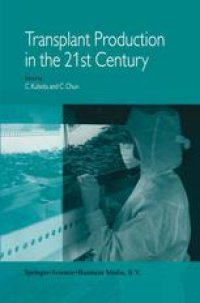
Ebook: Transplant Production in the 21st Century: Proceedings of the International Symposium on Transplant Production in Closed System for Solving the Global Issues on Environmental Conservation, Food, Resources and Energy
- Tags: Agriculture, Renewable and Green Energy, Plant Physiology, Plant Sciences, Systems Theory Control
- Year: 2000
- Publisher: Springer Netherlands
- Edition: 1
- Language: English
- pdf
We are facing global issues concerning environmental pollution and shortages of food, feed, phytomass (plant biomass) and natural resources, which will become more serious in the forthcoming decades. To solve these issues, immeasurable numbers of various plants and huge amounts of phytomass are required every year for food, feed and for the improvement of amenities, the environment and our quality of life. Increased phytomass is also required as alternative raw material for producing bio-energy, biodegradable plastics and many other plant-originated industrial products. Only by using phytomass as a reproducible energy source and raw material, instead of fossil fuels and atomic power, we can save natural resources and minimize environmental pollution. To increase phytomass globally, we need billions of quality transplants (small plants) to be grown yearly, in the field or in the greenhouse, under various environmental conditions. However, these high quality transplants can be produced only under carefully controlled, rather than variable environment al conditions. Recent research has shown that the closed transplant production system requires considerably small amounts of electricity, water, fertilizer, CO) and pesticide to produce value-added transplants as scheduled with minimum release of environmental pollutants and minimum loss of transplants. The closed or closed-type transplant production system is defined as a transplant production system covered with opaque walls with minimized or controlled ventilation rates, using artificial lighting. With this system, photoperiod, light intensity and quality, air temperature, humidity, CO) concentration and air current speed can be controlled as desired.
The outstanding points of this book are: 1) it is the first book focused on transplant production in closed systems, 2) many of the authors are acknowledged as the experts in their designated research area, and 3) the book covers both biological and engineering aspects of transplant production, and therefore, 4) it represents an integration of state-of-the-art, multidisciplinary technologies and knowledge. A book entitled Plant Production in Closed Ecosystems published in 1997 covers similar topics, but Transplant Production inthe 21st Century uniquely focuses on providing updated information and new concepts for a closed system that is suitable for transplant production in the 21st Century. It includes additional information related to biotechnology/micropropagation and micro-environmental analysis/control. Transplant Production in the 21st Century will be an important publication for the field of horticulture, agriculture and forestry, for researchers and engineers in biotechnology, greenhouse technology, information technology, and environmental control.